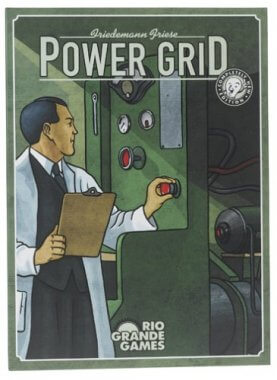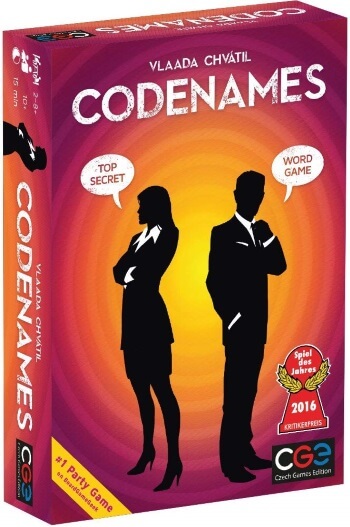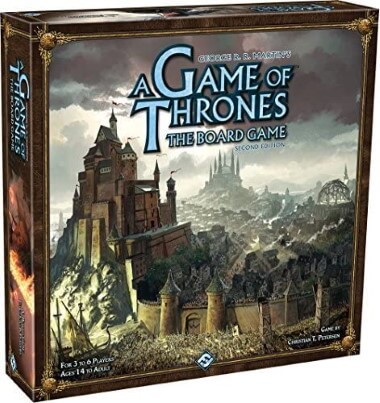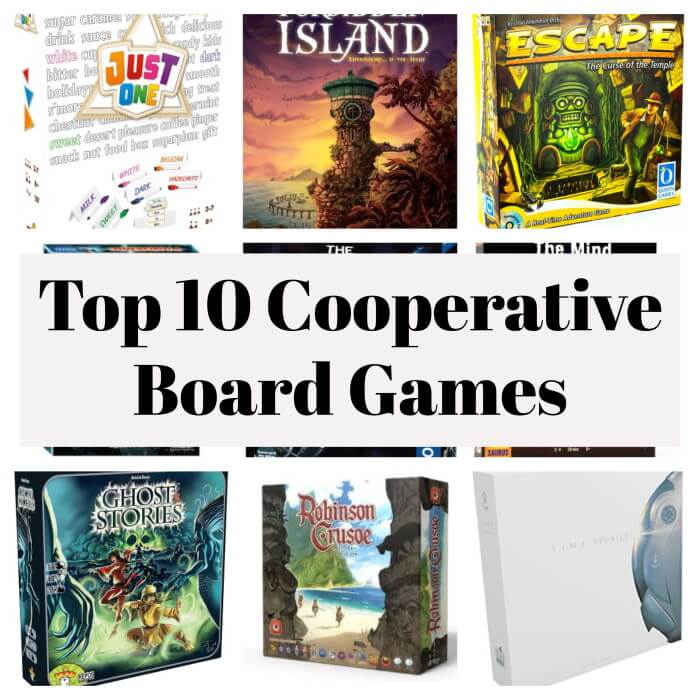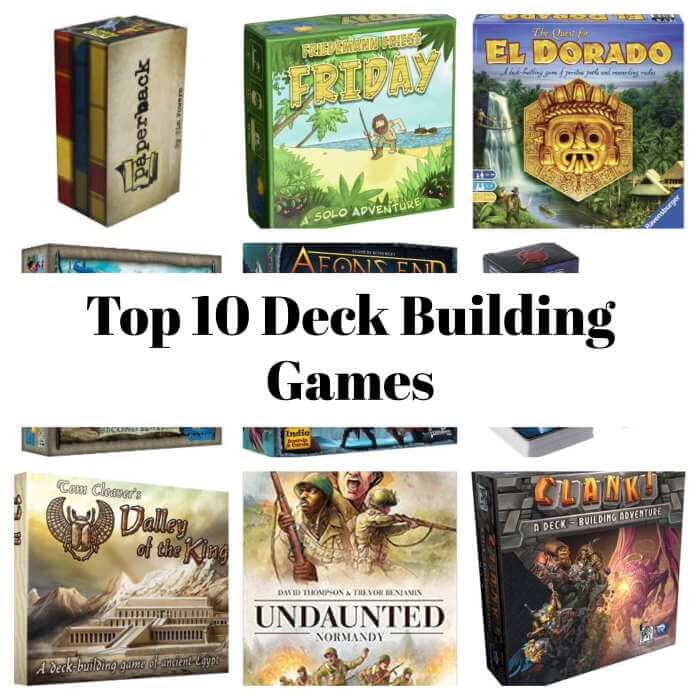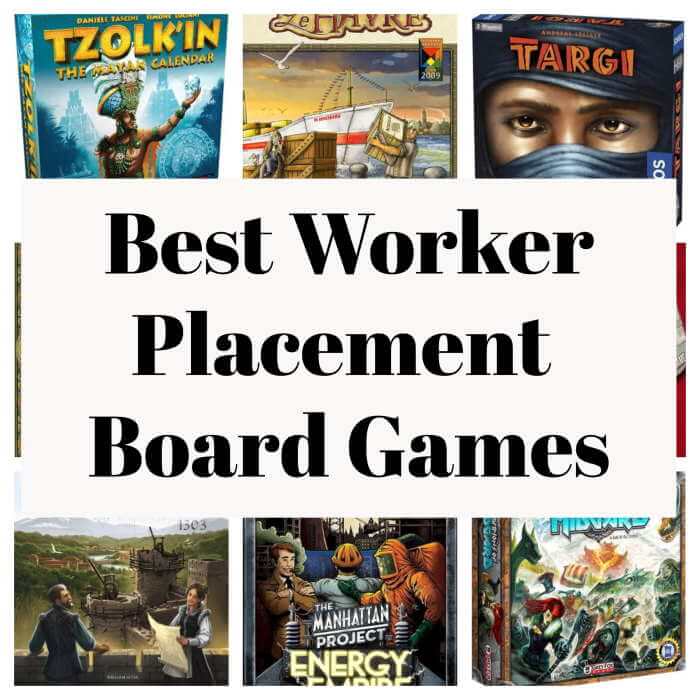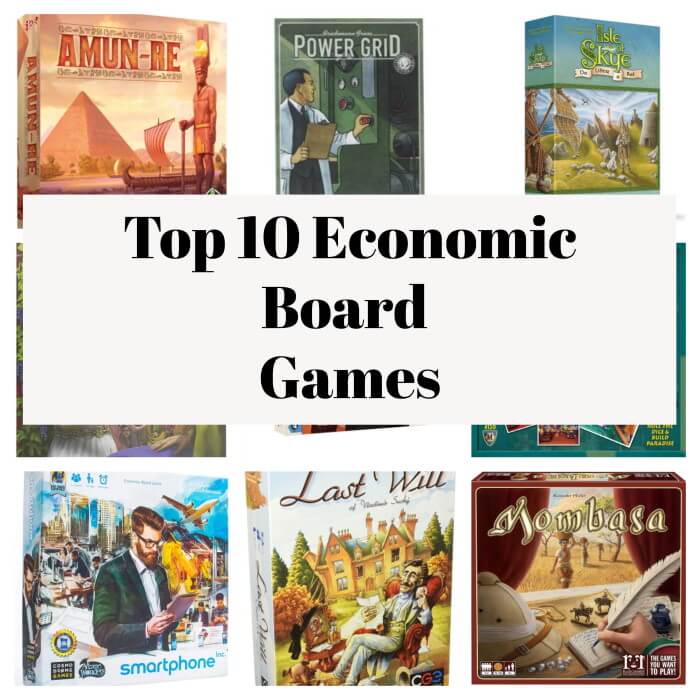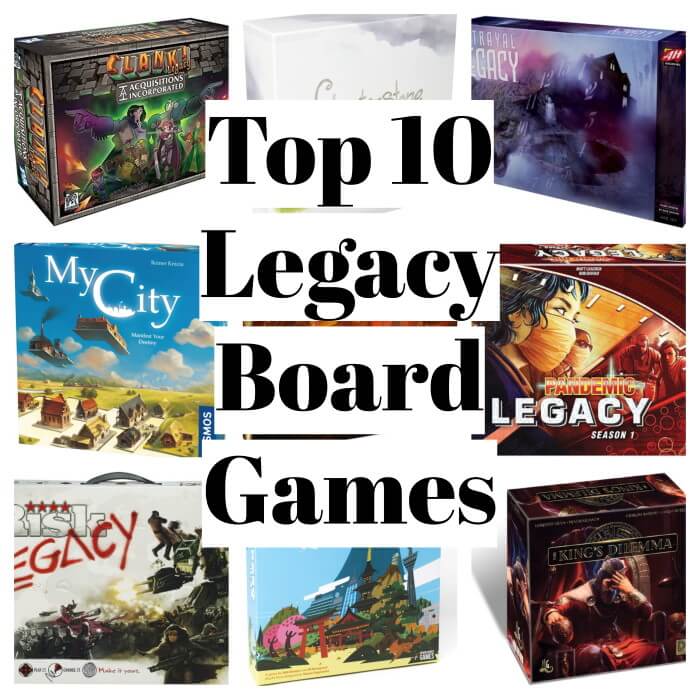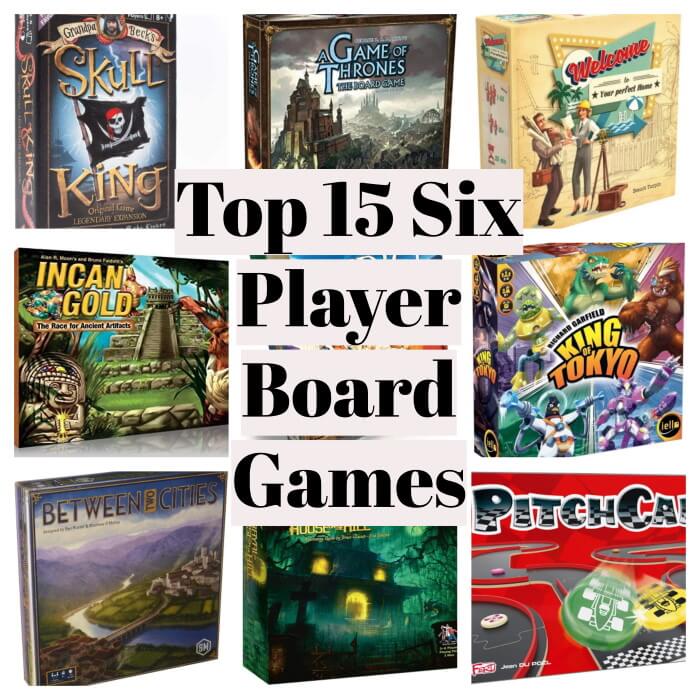
You’ve arranged a game night with five of your friends, and the big question will undoubtedly come up: which games to play?
Six players is kind of an awkward number – you could split the group into two groups, or find a game to play with all 6 players.
But sometimes you don’t really want to divide the group up, and finding a game to play with such large group of people can present its own challenges. For instance, how difficult will it be to teach that many people? Will there be a lot of downtime? Will it manage to keep people engaged?
The good news is we’ve come up with a list of 15 games that work exceptionally well with 6 players, spanning a wide range of games for various circumstances and preferences.
1. 7 Wonders – Best Card-Drafting Game
As will continue to be a trend with other games on this list, lack of down-time is a crucial element in scalability and ensuring a game plays well at high player counts such as a 6-player scenario.
7 Wonders, designed by Antoine Bauza, is a game that manages to pull off quick player turns, short game-length, and deep strategic decisions. Since it was released in 2010, 7 Wonders has managed to stay relevant as a go-to card drafting Euro/civilization building game and continues to make many hobby gamers’ top game lists.
Since it was released in 2010, 7 Wonders has managed to stay relevant as a go-to card drafting Euro/civilization building game.
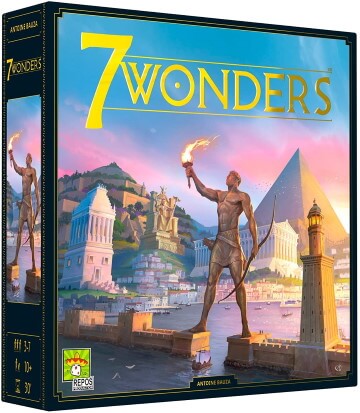
7 Wonders at a Glance
| Game Type Ancient Theme, Card Drafting, City Building, Civilization, Economic, Variable Player Powers, | Play Time 30 mins (approx) | Skill/Complexity (2.6 - 5) Light - Medium |
| Age 10+ | Publisher(s) Respos Productions | Published 2010 |
| Categories Family / Strategy | Players 2 - 7 Players | Our Rating 9/10 |
| Cost $29.99 approx |
As a leader of a city in the ancient world, your goal is to build up your city toward victory by using resources, building structures and wonders, growing your military power, and progressing in scientific fields.
7 Wonders is a card-drafting game in which players begin with a hand of 7 cards, then simultaneously pick a card, reveal that card (and pay any resource cost), and then pass the remaining cards to the player on their left. A round continues until all cards have been played, and the game consists of three rounds (ages).
7 Wonders is an interesting game in terms of player interaction. In the game, players interact quite a bit with the players to their right and left, with the ability to pay to use resources that they produce and also for evaluating military strength at the end of each age. It also scales very well due to the simultaneous nature of players turns, and the fact that players interact most with only two players at the table.
If you are looking for a “next-step” board game for people who have a couple games under their belt, like Carcassonne or Ticket to Ride, 7 Wonders could be a great fit for this purpose.
While the iconography takes a bit of explaining, it’s fairly easy to grasp once players have played through a round, and with a play length of only 30 minutes, it’s easy to jump back in and play a 2nd or 3rd round in one sitting.
While 7 Wonders fits perfectly within the 6 person board game category 7 Wonders Duel that came along 5 years later (2015) is also an excellent two player game.
2. Power Grid – Best Economic Game
Economic Euro-style games are not particularly well-known for playing well at higher player counts, due to the increased length of playtime and opportunities for analysis paralysis (AP).
Power Grid is a game that is much an exception to this rule, as it allows players to engage in some fairly complex interaction with other players without making the game drag on for a considerably longer amount of time.
Power Grid at a Glance
| Game Type Economic, Auction/Bidding, Catch the Leader, Network and Route Building | Play Time 120 mins | Skill/Complexity (3.5 - 5) Medium |
| Age 12+ | Publisher(s) Rio Grande Games | Published 2004 |
| Categories Strategy | Players 3 - 6 (4 - 5 is Ideal) | Rules Manual Official Rules PDF |
| Our Rating 9/10 | Cost $44.99 |
In Power Grid, designed by Friedemann Friese, players compete to have the most powerful energy company, and the player who can power the most cities on the map at the end of the game is the winner. Players achieve this goal by purchasing power plants through an auction, buying resources to fuel those power plants from a public market, expanding their network on the game board, and then powering cities on the board by running their power plants in order to gain money.
In Power Grid, designed by Friedemann Friese, players compete to have the most powerful energy company, and the player who can power the most cities on the map at the end of the game is the winner.
Although Power Grid is a moderately-heavy game (with a weight rating of 3.27 on BoardGameGeek), it still manages to work well with 6 players for a few reasons……….
First, having 6 players competing for spots on the board, power plants during auction, and resources in the resource market makes the game much more competitive. Second, because the game rounds are broken up into different phases, player turns can move at a much quicker pace without feeling like the round is dragging on far too long. Lastly, because the decisions that players make during any one of these phases in a round are relatively intuitive in relation to their end-game goal, the game can be fairly easy to explain to new players.
3. Medici – Best Auctioning Game
Dr. Reiner Knizia has designed over 700 published games, and he is certainly well-known for games featuring unique auction mechanisms. Medici, first published in 1995 and republished by Grail Games in 2016, is part of his famous auction trilogy (along with Ra and Modern Art).
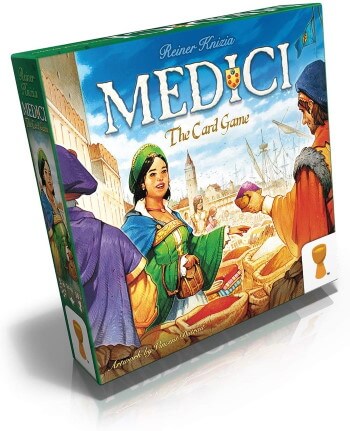
Medici at a Glance
| Game Type Card Game, Renaissance, Push Your Luck, Set Collection | Play Time 30 mins (approx) | Skill/Complexity (1.7 - 5) Light |
| Age 10+ | Publisher(s) Grail Games and Others | Published 2016 |
| Categories Family | Players 2 - 6 Players | Our Rating 8.3/10 |
| Cost $28.99 approx |
In Medici, players attempt to gain the most points at the end of three rounds by bidding on and acquiring “lots” of goods to load onto their cargo ship. On a player’s turn, they can reveal up to three cards from the top of the draw deck, but they may stop at one or two cards if they wish to do so. At that point, the lot of goods revealed goes up for auction, and there are a couple of aspects that make Medici a unique auction game: 1) points are money, so players bid points in order to gain goods cards; and 2) each player only bids once during an auction, so players only have one chance to put in their highest bid.
In Medici, players attempt to gain the most points at the end of three rounds by bidding on and acquiring “lots” of goods to load onto their cargo ship.
Once the draw deck is empty or all players’ cargo ships are full, the round is over and end-round scoring takes place. Players evaluate the total value of their cargo ship by adding the numbers at the top of their goods cards, and gain points according to their valued ranking compared to the rest of the group. Then, they move up tracks for each type of good in the game, and gain points for gaining first or second place for any type of good. At the end of each round, players do not reset their place on the goods tracks, so the second and third rounds become increasingly competitive as players vie for majority in different types of goods.
What makes Medici a great 6-player game, apart from being relatively quick and easy-to-teach, is the fact that there are no goods cards removed at the beginning of each round, making it less of a guessing/push-your-luck game (i.e., will a goods card appear?) and more of a strategic game (i.e., when will a particular goods card appear?). Also, since there are only 5 types of goods, this means that there is guaranteed to be more competition at a 6-player count.
All-in-all, if you are looking for a Knizia-style auction game that plays really well with 6 players, Medici is definitely one to look into.
4. 6 Nimmt! – Best Casual Card Game
Wolfgang Kramer is one of the most well-known designers of modern board games, having designed notable games such as El Grande, Tikal, The Princes of Florence, and Colosseum.
Back in 1994, Kramer published 6 Nimmt!, a casual card game that still remains largely popular, including on the online platform Board Game Arena.
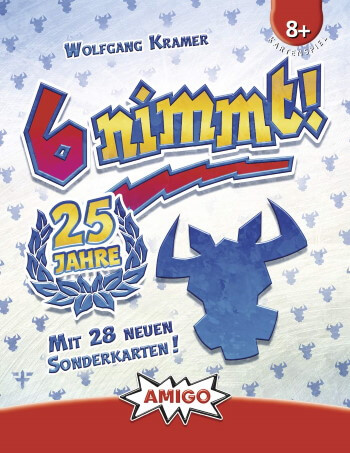
6 Nimmt at a Glance
| Game Type Card Game, Numbers, Kill Steal, Score-and-Reset Game, Simultaneous Action Selection | Play Time 45 mins (approx) | Skill/Complexity (1.3 - 5) Light |
| Age 8+ | Publisher(s) Amigo and Others | Published 1994 |
| Categories Family | Players 2 - 10 Players | Our Rating 7.3/10 |
| Cost $14.99 approx |
The central idea of 6 Nimmt! goes against most board games in that your goal is to gain the fewest number of points as possible. Over the course of the game, players will inevitably collect cards from the center of the table, with each card containing bull-head symbols at the top of the card. At the end of the game, whoever has the fewest number of bull heads is the winner of the game.
The central idea of 6 Nimmt! goes against most board games in that your goal is to gain the fewest number of points as possible.
More specifically, there are four rows of cards on the table, and on each turn, players simultaneously pick one card from their initial hand of 10 and reveal at the same time. Cards are numbered 1 to 104, and turn order is in ascending order from lowest card played to highest card.
Players take turns adding their card to the right-most end of a row. When they place a card, it must be a higher card than the card to its left, and the card must be added to a slot with the smallest difference between it and the previously-played card. In other words, there is only one possible place a player can put their card.
Rows can only have 5 cards, so if a player’s card would be the 6th card in the row, the player takes all those cards. Alternatively, if they cannot place their card because its value is too low, then a player chooses one row and takes all the cards in that row.
The game ends either once players have played all ten cards from their hand or once one player has gained 66 points (bullheads).
6 Nimmt! is a great 6-player game because the game features a higher level of player interaction with more players. Having more players just adds to the energy at the table with bluffing and trying to guess what other players are going to play on their turn as you try and figure out how high or low you want to play. It’s certainly a lot of fun when a player who has been talking a lot of trash is then forced to take a row with a lot of bullheads!
5. Incan Gold – Best Push-Your-Luck Game
Sometimes it’s a lot of fun in a game just to see how far you can push your luck at the prospect of a huge prize, but with the increasing risk of losing everything.
Incan Gold, designed by Bruno Faidutti and Alan Moon, is a quick game that puts players in the role of adventurers exploring a cave looking for treasure. In this game, players have one simple decision to make on their turn: to go deeper into the cave, or to head back to camp with the treasure safely tucked away.
In this game, players have one simple decision to make on their turn: to go deeper into the cave, or to head back to camp with the treasure safely tucked away.
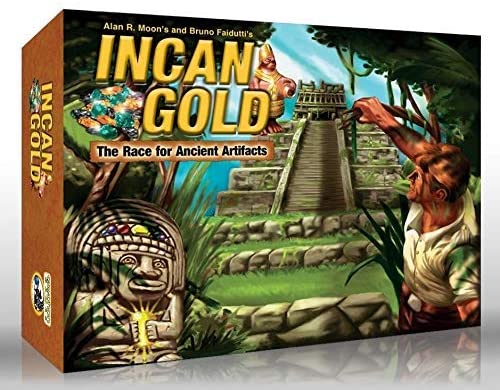
Incan Gold at a Glance
| Game Type Adventure, Bluffing, Exploration, Move Through Deck, Push Your Luck, Simultaneous Action Selection | Play Time 30 mins (approx) | Skill/Complexity (1.2 - 5) Light |
| Age 8+ | Publisher(s) Eagle-Gryphon Games and Others | Published 2005 |
| Categories Family | Players 3 - 8 Players | Our Rating 7.3/10 |
| Cost $25.99 approx |
Each turn, a card is revealed from the top of the quest deck for remaining players to evaluate, and will be a treasure, an artifact, or a hazard. Treasure cards divvy up a number of gems to the players currently exploring as depicted on the card. Artifacts stay in play and provide bonus points to one player if they are the only person to leave for camp during a turn. Hazard cards don’t do anything initially, but if a second hazard card of the same type is drawn from the deck, then all remaining players lose all their gems from the current quest.
Incan Gold plays 3-8 players, but the game is definitely more exciting at the higher player count (according to BoardGameGeek, it is best with 6-8 players) as there are more people competing for treasure in the cave.
Having more players at the table does not make the game drag on, since players make the decision to continue exploring or to head back to camp simultaneously.
Incan Gold would be a great fit for those looking for a very light-weight filler-style game that’s a lot of fun.
6. Codenames – Best Party Game
There are many popular classic party word games, like Scattergories or Pictionary, but Codenames is a game that brings fresh air to the party game genre with some modern design elements from well-known designer Vlaada Chvatl. It’s a team vs. team game, so naturally an even and high player-count of 6 works quite well for this game.
It’s a team vs. team game, so naturally an even and high player-count of 6 works quite well for this game.
The main idea of Codenames is that each team (red and blue) has a team leader whose goal is to have their team guess all their words correctly before the other team.
Codenames at a Glance
| Game Type Team Based, Word, Deduction, Memory, Push Your Luck | Play Time 15 mins (approx) | Skill/Complexity (1.5 - 5) Light |
| Age 14+ | Publisher(s) Czech Games | Published 2015 |
| Categories Family Party / Word | Players 2 - 8 + (best 6 - 8) | Rules Manual Official Rules |
| Our Rating 9/10 | Cost $19.99 approx | Related Codenames Duet Games Like Codenames |
The game consists of a grid of cards set on the table, with each card containing a word. A key card is made visible to the team leaders, and depicts which cards on the table belong to their team, and which card represents the assassin. On their turn, the team leader will give a clue to their team containing one word and a number in order to get them to guess the most word cards as possible. In other words, they must get creative in categorizing certain word cards in a way they suspect will lead their team to point to the correct cards.
When a team guesses a word card that correctly belongs to them, they replace the card with a card of their team’s color. If they guess incorrectly, and that word belongs to their opponents, that word card is replaced with a card of the other team’s color. If they guess the card that is the assassin, their team loses immediately.
Codenames has definitely become a staple party game in many hobby gamers’ collections, which comes as no surprise as it won the Spiel des Jahres award in 2016.
If you’re already a fan of this game you might want to check out our top games list like Codenames.
There have been many iterations of the game released since then, such as Codenames: Pictures, Codenames: Marvel, Codenames: Disney Family Edition and the two player Codenames: Duet. In any case, the game works very well as a 6-player game, and if you are looking for a solid party game for your collection, Codenames is worth checking out.
7. Welcome To – Best Flip-and-Write Game
Roll-and-write games, in which players roll dice and fill in a sheet of paper based on the numbers they roll, have become immensely popular in recent years.
Designers have also taken this core concept and added some twists along the way, such as substituting a deck of cards for dice, as in the case of Welcome To, designed by Benoit Turpin.
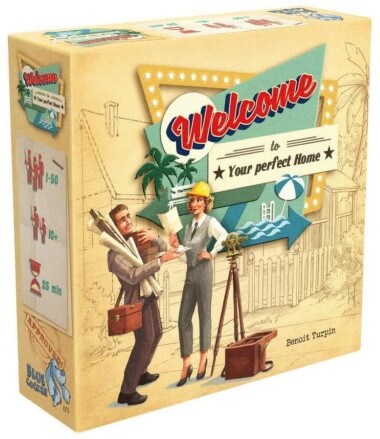
Welcome To at a Glance
| Game Type City Building, Paper-and-Pencil, Pattern Building, Solo/Solitaire Game | Play Time 25 mins (approx) | Skill/Complexity (2 - 5) Light |
| Age 10+ | Publisher(s) Deep Water Games and Others | Published 2018 |
| Categories Family | Players 1 - 100 Players | Our Rating 8.8/10 |
| Cost $29.99 approx |
In Welcome To, players are building up an empty neighborhood on their individual player sheets. Each turn, three sets of cards are revealed, each containing a number and an action, and players simultaneously choose one of these sets to execute on their player sheet. Numbers are used to fill in houses in ascending order in any of the three streets, and actions allow players to either bend the rules slightly in terms of number placement, or gain points by filling in areas at the bottom of their sheet.
In Welcome To, players are building up an empty neighborhood on their individual player sheets.
Players can also gain bonus points by completing special objectives as revealed at the beginning of the game.
What makes flip-and-write/roll-and-write games work especially well with higher player counts is the fact that most of them allow for simultaneous play, thus eliminating a lot of downtime that can typically be found with more players are the table.
Welcome To is a great pick for this category because it is easy to teach, but offers a wide enough variety of avenues to explore in terms of strategy to keep more experienced gamers interested and engaged.
8. The Resistance – Best Social-Deduction Game
Do you like the idea of trying to be clever in piecing together bits of information and subtle social cues to try and determine if someone is lying? Does the prospect of trying to weave together an intricate web of deceit in order to deflect attention and cause others to chase after an innocent person get your adrenaline pumping? If you answered yes to either of these questions, then The Resistance is a game that will probably bring a smile to your face.
The Resistance, designed by Don Eskridge, is a game in which players receive a secret role at the beginning of the game: they are either a member of The Resistance trying to take down a corrupt government, or a secret government spy. From the moment players receive their role, the game creates a tense atmosphere of mistrust and paranoia.
The Resistance, designed by Don Eskridge, is a game in which players receive a secret role at the beginning of the game.
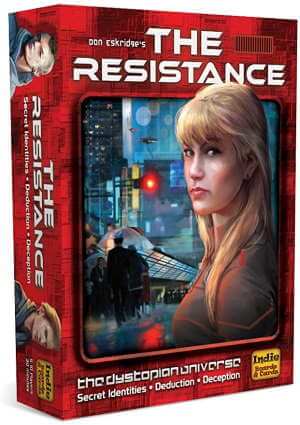
The Resistance at a Glance
| Game Type Bluffing, Card Game, Deduction, Negotiation, Hidden Roles, Memory, Team Based, Spies/Secret Agents, Traitor, Voting | Play Time 30 mins | Skill/Complexity (1.8 - 5) Light |
| Age 13+ | Publisher(s) Indie Boards & Cards and Others | Published 2009 |
| Categories Party | Players 5 - 10 | Cost $29.99 |
| Our Rating 8.3/10 |
The game is played over five rounds in which a certain number of people will go on missions and will be elected by the current mission leader of the round (and voted on by the group). People who are selected for a mission will either secretly succeed or fail the mission, and if just one person plays a fail card, the entire mission fails – and everyone at the table will have one piece of information in picking out the spies from the group. The Resistance wins the game if they succeed in 3 of the 5 missions, and the spies win if they manage to fail 3 out of the 5 missions without being caught.
Because of its social nature, The Resistance is naturally best-suited for high player counts, making it great for our 6-player scenario at hand.
This is definitely a game that can create stories that will be told amongst a group of friends for many years to come.
It’s also a game that can be fun to play with the same group of people over and over again as a metagame will begin to evolve; people will learn to read certain players’ social cues as to whether they are lying or telling the truth.
If this all sounds like your idea of a good time, then The Resistance is worthy of your time.
9. Betrayal at House on the Hill – Best Thematic Game
You were strolling about the neighborhood late one night with a group of friends when you stumbled across an eerie house, and naturally, you decided to go in to explore. What could possibly go wrong?
Trapped in a house full of monsters, nightmarish visions, maleficent entities, chilling omens, and portals to hell, you work together to make your way through the house and discover items that help you along the way. That may all seem great, but little did you know that there has been a betrayer among you since the moment you stepped foot into the house.
That may all seem great, but little did you know that there has been a betrayer among you…………
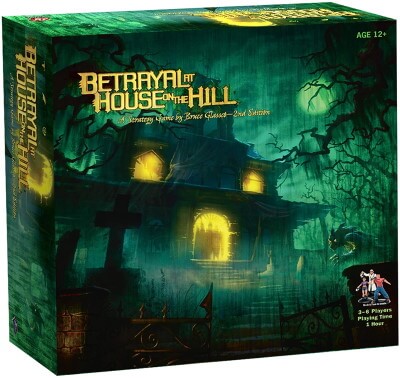
Betrayal at House on the Hill at a Glance
| Game Type Adventure, Exploration, Fantasy, Miniatures, Dice Rolling, Map Addition, Modular Board, Player Elimination, Role Playing, Team-Based Game, Traitor Game, Variable Player Powers | Play Time 60 Mins | Skill/Complexity (2.4 - 5) Light - Medium |
| Age 12+ | Publisher(s) Avalon Hill Games and Others | Published 2004 |
| Categories Strategy / Family | Players 3 - 6 | Cost $47.99 approx |
| Our Rating 9/10 |
In Betrayal at House on the Hill, players each pick a different role, and associated stats, at the beginning of the game.
Players take turns moving through the house, discovering items and encounters, and evaluating omen cards which require a haunt roll. The haunt roll is a critical part of the game in that it is what can trigger the haunt, which then transitions players into the second half of the game.
The player who is revealed as the traitor (as determined by where the haunt was triggered and with which omen card) is pitted against the rest of the players, and both sides receive special instructions and objectives for the particular scenario at hand.
Betrayal at House on the Hill is a thematic game that can provide an entertaining experience with the right group of friends who are willing to get into the theme and have some fun. It’s definitely more focused on thematic aspects than strategic or mechanical, and players who don’t like much randomness or luck may not enjoy this game.
The sheer amount of replayability in the box with 50 scenarios means that two games will almost never be the same, and this game can definitely be a blast with its maximum player count of 6.
10. King of Tokyo – Best Family Game
Are you stuck trying to figure out what game would be best to bring to your next family gathering? Are you in need of a game that can play well with a larger group of 6 players, and with a mix of age ranges and gaming experience? Do you like fun? Then King of Tokyo is a game to bring along, and almost guaranteed to be a highlight of the evening.
As a monster trying to become King of Tokyo, you must be willing to do anything it takes and to defeat your enemy monsters who seek to keep you down.
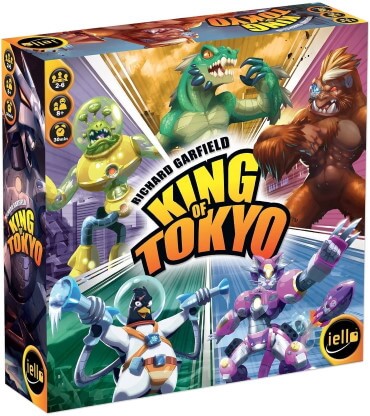
King of Tokyo at a Glance
| Game Type Science Fiction, Card Drafting, Dice Rolling, King of the Hill, Player Elimination, Push Your Luck | Play Time 30 Mins | Skill/Complexity (1.5 - 5) Light |
| Age 8+ | Publisher(s) IELLO and Others | Published 2011 |
| Categories Strategy / Family | Players 3 - 6 | Cost $34.99 approx |
| Our Rating 8.9/10 |
The goal of King of Tokyo, designed by Richard Garfield, is simple: be the last player standing, or be the first to reach 20 points. Players take turns rolling dice Yahtzee-style (i.e., they get to roll three times and set aside any dice they’d like to keep), and then use those dice to earn points, heal up, attack opponents, and purchase power cards that provide immediate or ongoing bonuses.
The goal of King of Tokyo, designed by Richard Garfield, is simple: be the last player standing, or be the first to reach 20 points.
A fun aspect of the game is that if Tokyo is currently unoccupied, you must move your monster into the city. You gain points for entering the city, and for beginning your turn in the city, but it also means that you must fight off all other players alone and cannot use health points rolled from dice while they are in the city. Players can leave the city, however, once they lose health points by being attacked by another player.
With incredibly simple rules, King of Tokyo is a game that is easy to jump right in and teach other players as you go. The theme is one that many people, adults and children alike, will enjoy, and the game can lead to many exciting and memorable moments. This is definitely a game to look into if it sounds like it could be a good fit for you!
11. A Game of Thrones: The Board Game – Best Heavy-Weight Game
While many games that play well at the 6-player count tend to be ones that feature quick turns and easy-to-grasp rules, sometimes it’s the deep, strategic, and thematic experience that you are looking for.
If you are a fan of the book or TV series, then A Game of Thrones: The Board Game is everything that you would hope it would be: full of plotting, scheming, and backstabbing all to bring your family honor in the land of Westeros.
Game of Thrones at a Glance
| Game Type TV & Book Theme, Wargame, Fantasy, Bluffing, Negotiation, Area Majority / Influence, Area Movement, Auction/Bidding, Player Elimination, Variable Player Powers | Play Time 120 - 240 mins + | Skill/Complexity (4 - 5) Medium - Heavy |
| Age 14+ | Publisher(s) Fantasy Flight Games | Published 2003 - Latest 2011 + expansions (including 2018) |
| Categories Strategy / Fantasy | Players 4 - 6 (6 Ideal) | Cost $59.99 |
| Our Rating 9/10 | Instructions/Rules Official Rules PDF |
In A Game of Thrones, designed by Christian T. Petersen, players take on the role of one of the famous houses of Westeros – Stark, Greyjoy, Baratheon, Lannister, Martell, and Tyrell. The winner of the game will be the player who is first to control seven areas that contain a castle or stronghold on the game board, or the player who controls the most areas with a castle or stronghold at the end of 10 rounds.
The winner of the game will be the player who is first to control seven areas that contain a castle or stronghold on the game board.
While there is a lot going on in A Game of Thrones, the basic round structure is divided into three phases: Westeros, Planning, and Action.
In the Westeros Phase, players resolve the effects and actions of cards drawn from 3 different decks. In the Planning Phase, players enter into diplomatic and persuasive interaction with other players, sometimes truthful and (as fitting to the theme) sometimes deceitful, as well as assign order tokens to units on the board with face-down order tokens. In the Action Phase, players carry out the actions from their order tokens placed in the previous phase, and players engage in and evaluate the result of battles between units on the board.
A Game of Thrones may not be a game that you necessarily decide to play at every game meetup or when you have a chance to play with 6 players, due to its length and complexity. However, it is a memorable game that can provide a tense and engaging strategic experience – especially at the 6-player count, given that every faction included in the game will be present on the board.
If you have a group of friends who love the A Song of Ice & Fire book series, or Game of Thrones TV show, then this could definitely be a game that you will have a lot of fun with.
12. PitchCar– Best Dexterity/Racing Game
If you are looking for a game that’s just plain and simple fun with almost no rules and is almost guaranteed to be a hit success, it’s hard to beat PitchCar for this spot in a gamer’s collection.
At first glance, PitchCar will bring back childhood memories of playing slot cars, with a sprawling wooden track. But PitchCar is a game that’s all about flicking disks in a race to be the first player to complete three laps.
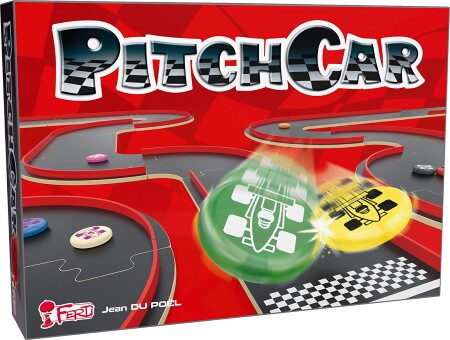
PitchCar at a Glance
| Game Type Action/Dexterity, Racing, Sports , Flicking, Modular Board | Play Time 30 Mins | Skill/Complexity (1 - 5) Light |
| Age 6+ | Publisher(s) Eagle-Gryphon Games and Others | Published 1995 |
| Categories Party / Family | Players 2 - 8 | Cost $39.99 approx |
| Our Rating 8/10 |
PitchCar is a perfect 6-player game in the sense that having a large number of players contributes to the energy around the table as players race to get their disks around the winding track. What’s even more exciting about the game is the fact that there are different expansions that add really fun elements to the race track, like a loop and jumps.
PitchCar is a perfect 6-player game in the sense that having a large number of players contributes to the energy around the table.
With so many different types of configurations, the game opens up plenty of opportunities for creativity.
While PitchCar is a bit on the pricey side, it has very solid components with thick wooden pieces that fit together, and is almost guaranteed to last a very long time and withstand some use and abuse over the years.
It is a game that family and friends will definitely look forward to, and one that kids and adults alike will be able to enjoy.
13. Skull King – Best Trick-Taking Game
Fans of classic trick-taking card games, like Hearts, Spades, and Euchre, as well as people who enjoy Pirate-themed games, will likely appreciate everything Skull King has to offer.
This game takes classic elements found in older trick-taking games and adds some fresh and new ideas that will likely appeal to both casual and hobby gamers alike.
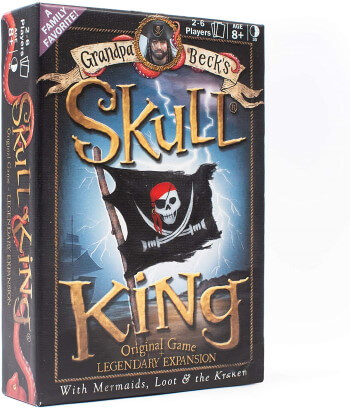
Skull King at a Glance
| Game Type Nautical Theme, Pirates Them, Card Game, Predictive Bid, Trick-taking | Play Time 30 Mins | Skill/Complexity (2 - 5) Light |
| Age 8+ | Publisher(s) Grandpa Beck's Games and Others | Published 2013 |
| Categories Family | Players 2 - 6 | Cost $14.99 approx |
| Our Rating 8.9/10 |
In Skull King, designed by Brent Beck, the goal is to gain the most points after ten rounds. In each round, players receive cards equal to the current round number, and then they simultaneously and secretly bid on the number of tricks they think they will win in that round. Once bids have been revealed, the player to the left of the dealer leads the trick. Then, each player in clockwise order plays a card from their hand, and the winner of the trick is determined.
In Skull King, designed by Brent Beck, the goal is to gain the most points after ten rounds.
At the end of the round in Skull King, players who correctly guessed the number of tricks they would take gains 20 points per trick. Players who guessed incorrectly receive minus 10 points multiplied by the number of tricks they were off from their bid. Players who bid correctly that they would take zero tricks receive 10 points multiplied by the current round number (if they bid incorrectly in this case, they receive minus 10 points multiplied by the current round number).
Apart from standard numbered cards, Skull King features different types of cards that can players can play from their hand – even if they have a card in hand of the leading suit – which have different effects in the game. For instance, Escape cards carry a zero-value and essentially guarantee that the player will lose the trick. Pirate cards are higher than all other cards in a suit, and Skull King cards trump everything.
If you are a looking for a game to play with 6 players that has a classic card-game feel to it, but that offers some fun and exciting changes, then Skull King is an easy pick for this category.
The simultaneous secret bidding at the beginning of each round of this game makes for some tense and exciting moments, and the special cards provide the opportunity for some interesting decisions and interaction between players.
14. Bohnanza – Best Negotiation Game
Designer Uwe Rosenburg is often associated with big heavy sprawling Euro games with a massive number of components, but he has also designed some games on the light/family end of the game spectrum.
Bohnanza, a negotiation card game about bean farming, is one of these lighter games, and has been nominated for some awards since it was first released in 1997.
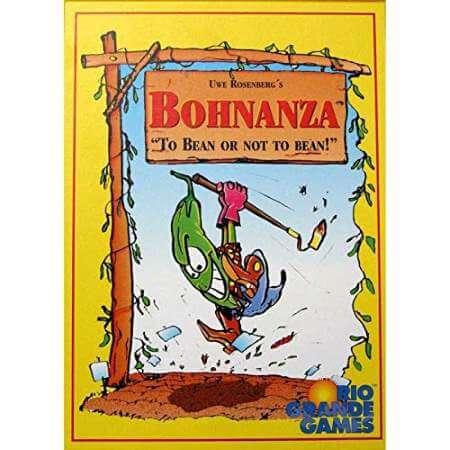
Bohnanza at a Glance
| Game Type Farming Theme, Negotiation, Card Game, Trading | Play Time 45 mins + | Skill/Complexity (1.8 - 5) Lightweight |
| Age 12+ | Publisher(s) Rio Grande Games and Others | Published 1997 |
| Categories Strategy / Family | Players 2 - 5 (5 is Ideal) | Manual Official Rules |
| Our Rating 9/10 | Cost approx $19.99 |
The main idea of Bohnanza is that players are attempting to earn the most money over the course of a game by planting, harvesting, and selling beans for money.
The main idea of Bohnanza is that players are attempting to earn the most money over the course of a game by planting, harvesting, and selling beans for money.
While Bohnanza may seem like a fairly simple set-collection card game, there are a couple of mechanical twists that make the game stand out. First, players must plant bean cards from their hand, but they may not rearrange their order. In other words, a player may only play the card that has been in their hand the longest. Second, a player’s turn involves a trading phase in which they draw 2 cards from the deck to put face up in their trading area, and then initiate trading with other players at the table, which can include any cards from their hand.
These two mechanisms take a very lightweight family card game and add both a strategic planning element (in terms of card order and hand management), as well as some light-hearted and fun negotiations between players at the table.
This game works exceptionally well with 6 players because the higher player count adds to the energy of the game, with more opportunities to wheel-and-deal with multiple players and make all kinds of promises.
If you are looking for a small-box game that can provide a lot of fun with a large gathering of friends or family, Bohnanza is a game you can almost always bring along.
15. Between Two Cities – Best City-Building Game
For some people, the idea of playing a game that features lots of negative “take-that” player interaction sounds like a terrible time; they would prefer to play a game that promotes positive collaboration between players.
For other people, the idea of playing a cooperative game in which all players collectively win or lose against the game itself sounds like a terrible time.
Can there possibly be a game that has potential to appeal to both preferences? Actually yes – and that game is called Between Two Cities.
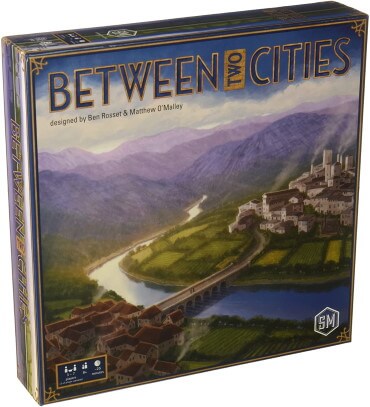
Between Two Cities at a Glance
| Game Type City Building, Negotiation, Card Drafting, Highest-Lowest Scoring, Set Collection, Simultaneous Action Selection, Solo/Solitaire Game, Tile Placement, Kickstarter | Play Time 25 Mins | Skill/Complexity (2 - 5) Light |
| Age 8+ | Publisher(s) Stonemaier Games and Others | Published 2015 |
| Categories Family | Players 2 - 6 | Cost $26.99 approx |
| Our Rating 8.9/10 |
Between Two Cities is a tile-placement city-building game in which buildings provide points for meeting certain objectives. The interesting twist with this game, however, is that players build two separate cities which they share with the players sitting on either side, and the points they receive at the end of the game are based on their lowest-scoring city of the two. In other words, they must collaborate with the player both on their right and their left as evenly as possible in order to try and maximize their points at the end of the game.
The interesting twist with this game, however, is that players build two separate cities which they share with the players sitting on either side.
The game is played over three rounds, each of which consists of players drawing tiles, secretly picking two, and then collaborating with players on either side as to where tiles will be placed. Different types of buildings have different scoring conditions; for instance, Taverns score for unique sets of different tavern symbols, and Shops score points for being in a straight line.
Between Two Cities is a great 6-player game because of the multiple partnerships that occur around the table with such a large group, and it’s interesting to see how different people work together to build the best city. It’s also a very quick game (25 minutes) and one that is easy to teach and comprehend.
As mentioned above, this is a game that feels both cooperative and competitive – cooperative in the sense that players have to work together, but competitive in the sense that there is only one winner in the game. For these reasons, it has the capacity to appeal to a very wide range of gamers.
That’s about it in our Best 6 Player Board Games top picks category. We do an annual review of these to see what additions could be worth adding and any removals for better games.
